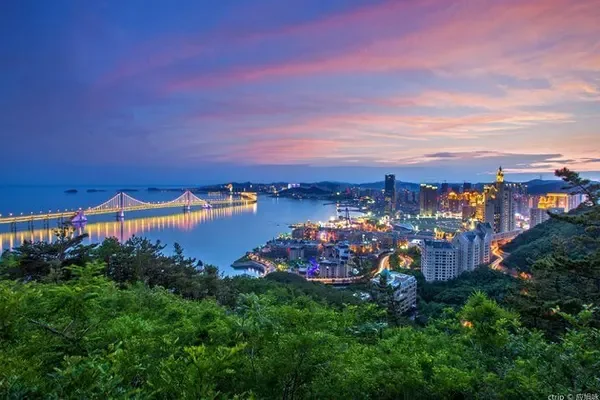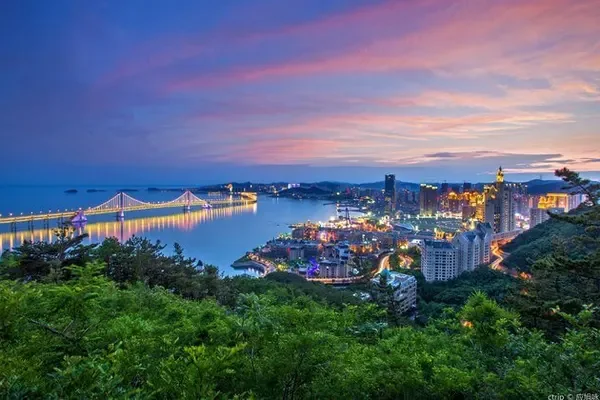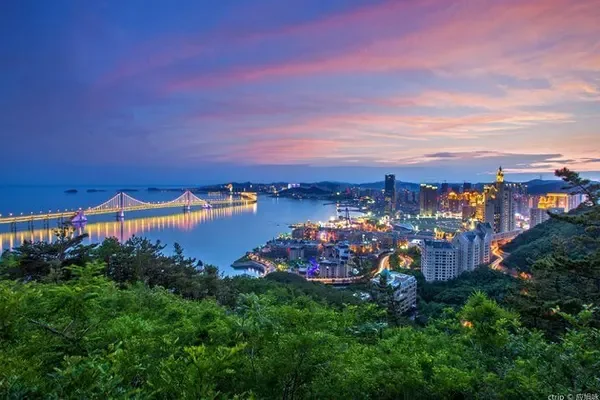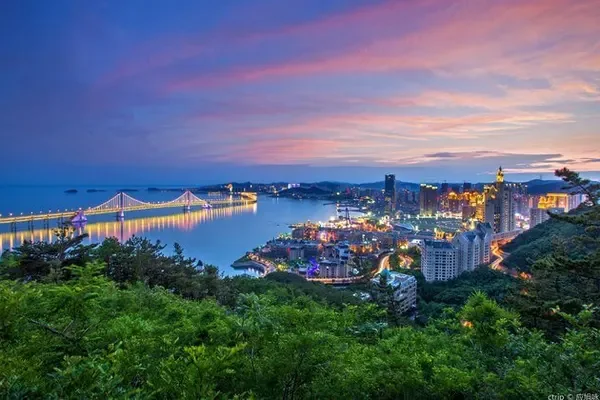In order to live up to the kindness of the people of Shanxi for free tickets to Jiangsu, Zhejiang and Shanghai, in April 2021, a group of four of us started a trip to Shanxi and Northern Shaanxi. In fact, I have been planning to travel to Shanxi and northern Shaanxi for a long time. I originally planned to drive there from the place of residence. Since the distance is too far, the round trip is more than 4,000 kilometers, so I changed it to fly to Taiyuan first, and then rent a car from Taiyuan to travel by car. See the route map for details.

DAY1: Airport--Qiao Family Courtyard--Pingyao Ancient City
The flight booked on Ctrip.com arrived at Taiyuan Wusu Airport at 11:00 noon after nearly 2 hours of flying, and successfully got a rental car from EHI in the airport parking lot. After a brief lunch, he went straight to Qiao's courtyard. It's a pity that the weather was not beautiful, and it started to rain, but it didn't affect the mood of visiting Qiao's compound at the first stop.

Qiao's courtyard in the rain.




After finishing the tour of the Qiao Family Courtyard, at around 4:00 p.m. that day, I stayed at the Pingyao Xinhuiguan Hotel next to the ancient city of Pingyao, feeling very Shanxi merchant culture.

After settling down, I visited the county government in the ancient city before the scenic spots closed (the ancient city is not closed, and the scenic spots inside are closed at 18:00).






The second hall is the daily office of the county magistrate.

Tips:
1. In 2021, Shanxi's policy of free admission to Jiangsu, Zhejiang and Shanghai does not include the Qiao Family Courtyard. It is said that the Qiao Family Courtyard is a local scenic spot and not owned by the National Tourism Administration.
2. The scenic area of Pingyao Ancient City is very large and cannot be entered by self-driving cars. It is not only physically impossible to come by walking, but also takes too much time. It is recommended to take a battery car in the scenic area. It is more expensive for a single ride. It is best to charter a car for 150-160 yuan a day. We chartered the same car from the afternoon to the next morning.
DAY2: Pingyao - Hukou Waterfall
On the second day, continue to visit the ancient city of Pingyao.
Pingyao Ancient City is currently the only ancient county in my country that has successfully declared the world cultural heritage with the entire ancient city. The streets, shops and dwellings in the ancient city still maintain the traditional layout and style. It used to be the financial center of China in the late Qing Dynasty. Since I had negotiated with the driver of the battery tour bus the night before, I took the battery car early the next morning. I continued to visit the ancient city in the morning and mainly visited the Chenghuang Temple, Confucian Temple, Nine Dragon Wall, Rishengchang, Escort and so on.










End the tour of the ancient city of Pingyao in the morning, and come to the Wang Family Courtyard in the afternoon.







In the evening, I came to the Yellow River Waterfall Scenic Spot in Jixian County and stayed at Zhao's Private Kitchen B&B (booked by Ctrip).
Tips:
1. Personally, I feel that the Wang Family Courtyard is more attractive than the Qiao Family Courtyard in terms of scale and momentum. The Qiao Family Courtyard has a strong commercial atmosphere.
2. If you plan to stay in Hukou Waterfall, there are more choices in Jixian County, Shanxi than in Shaanxi. It is convenient to go to and from both sides, as long as you cross a bridge.
3. There are a lot of apples in Ji County, Shanxi, which are original and delicious, and cost 10 yuan and 4 catties.
DAY3: Hukou - Qiankun Bay - Yan'an
In the morning, enjoy the free breakfast at Zhao's B&B.

Since the Hukou scenic spot in Shanxi will be renovated until April 28, we had to visit Hukou in Shaanxi. The Yellow River Waterfall Scenic Spot in Shanxi came by scenic shuttle bus early in the morning.






After visiting Hukou Waterfall in the morning, drive to Qiankun Bay Scenic Area.
"The Yellow River has ninety-nine bays in the world, and Qiankun Bay is the most beautiful." There are two Qiankun Bays, located in Yanchuan County, Shaanxi Province and Yonghe County, Shanxi Province. The Yellow River makes a sharp 320-degree turn here, known as the first bend of the Yellow River in the world. According to legend, Fuxi, the originator of the Chinese nation, came here many times to look up at the sky and down at the rivers and mountains. Facing the natural S-shaped big turn here, the sage enlightened his mind, enlightened the Taiji diagram, and created a precedent for Chinese civilization. In order to commemorate the "Taiji Picture" created by Fuxi, later generations named this scenic spot of the Yellow River "Qiankun Bay".
Generally, if you search for "Qiankun Bay" on Baidu, the one in Yanchuan is the first one to come up. In fact, the one in Shanxi is also good, and many small scenic spots are found along the way.
On the way from Hukou to Qiankun Bay, I saw the Red Army's Eastern Expedition Monument on the side of Provincial Highway 248.

The Qiankun Bay Scenic Spot in Yonghe, Shanxi is relatively simple and takes about an hour to visit. As soon as you enter the gate, there is a Yellow River Serpentine Geological Museum. The best viewing platform in the scenic area is the Qiankun Terrace. There are various gossip elements around the Qiankun Terrace. It is said that in ancient times, Fuxi watched the sky at night and created the Yin-Yang Bagua. Qiankun Bay is like a naturally formed picture of Tai Chi, with curves with an arc of more than 320 degrees and different scenery in four seasons. It is worthy of being the first bay of the Yellow River. , the place where the universe is determined.




Shanxi Yonghe Qiankun Bay is a simple geological park with no food and accommodation service facilities. After the tour, you can only go to Yan'an to stay.
Tips:
1. Qiankun Bay in Yanchuan, Shaanxi has complete facilities for play, entertainment, and accommodation. There are no charges here in Shanxi. It is still under development and there is no charge, but the scenery is not bad at all.
2. From Hukou to Qiankun Bay in Shanxi, there are many winding roads, with 320-degree bends everywhere; but from Qiankun Bay to Yan'an, the Yellow River No. 1 highway has just been repaired, and the road condition is very good.
DAY4: Yan'an - Jingbian Wave Valley
In the morning in Yan'an, we mainly visited Baota Mountain, the former site of Luyi, and Zaoyuan. Pagoda Mountain is located in the center of Yan'an City. The pagoda was first built in the Tang Dynasty and rebuilt in the Ming Dynasty. Pagoda Mountain is an important symbol and symbol of Yan'an, the sacred place of Chinese revolution.




Lu Yi is the first college established by the Communist Party of China in Yan'an to train various high-level and intermediate cultural and artistic talents.










Zaoyuan was originally a manor of a landlord. At present, the small auditorium of the Central Secretariat, the former residences of great people, the "Serving the People" speech platform, the Central Medical Office, and the Happiness Canal have been opened.




End the tour in Yan'an at noon, and drive to the Wave Valley in Jingbian to stay at the local homestay.
Tips:
1. Yan'an is already an international metropolis, with severe traffic jams in the morning and evening, and the impression of the war years can no longer be found. Pagoda Mountain is in the urban area, and people usually choose to enjoy Baota Mountain, Qingliang Mountain, Fenghuang Mountain, etc. along the Yanhe River. I feel that there are many scenic spots on Qingliang Mountain. Due to time constraints and the weather is not beautiful, I only read Jiefang Daily and People’s Daily Museum. .
2. The old site of Luyi in Yan'an has fewer tourists and more content to see, which is worth recommending.
DAY:5 Wave Valley --- Yulin
Wave Valley shows a wonderful world carved by wind, water and time for millions of years. The dunes are continuously covered by layers of red sand impregnated with groundwater. Over time, the minerals in the water condense the sand into sandstone, forming a layered structure.
Jingbian Wave Valley is divided into a main scenic spot (tickets are 110 yuan) and several "wild" scenic spots (tickets are not charged for fellow villagers leading the way)
Wave Valley by the B&B

Donkey Friends Photography Base



Crocodile Mouth Scenic Area and Abandoned Cave Dwellings


Longquan Danxia Scenic Area



At noon, I had lunch at the homestay where I lived, and drove to Yulin, and visited the Pineapple Castle on the way. Polo Castle is located on the south bank of the Wuding River 25 kilometers northeast of Hengshan County, Yulin City. It was built in the Northern Wei Dynasty and has a history of more than 1,400 years. The legendary Fortress of the Fortress. Currently being renovated, the most famous ones are the Lingxiao Tower and the ancient brick kiln.




On the way to Yulin, the Mu Us Desert passed by has become an oasis, thanks to the efforts of generations of sand control people.
In the evening, I stayed at the Yijia Hotel booked through Ctrip. I really felt like going home. There is an old Zhangji Braised Vegetable King next to the hotel. The quantity is large, delicious, and the price is reasonable.

Tips:
1. The wave valley scenic area is very large. Except for the No. 1 scenic spot which charges tickets, other scenic spots (we call it "wild" scene) are under development and do not charge tickets, but the scenery is not bad.
2. We did not go to scenic spot No. 1 mainly because of the weather and physical strength, not to save ticket money. It is said that scenic spot No. 1 needs to climb up and down. "Wild" scenery needs to pack the car of the local people, it is best not to go in by self-driving car, the local people will stop the car and charge...
DAY6: Yulin--Zhenbeitai--Qikou Ancient Town
After the taste buds were satisfied, Meimei took a good night's sleep, and went to visit the ancient city of Yulin early the next morning.
The ancient city of Yulin has a history of more than 600 years. It is an important nine-border town in history. It is also the second largest city in Shaanxi Province in the Ming Dynasty after Xi'an. It is said that during the Anti-Japanese War, when Japanese planes bombed Yulin, there was not enough fuel, and the ancient city was turned back halfway. save.
From south to north, the ancient city stands six ancient buildings: Wenchang Pavilion, Wanfo Tower, Xinming Tower, Bell Tower, Kaige Tower, and Drum Tower, echoing Zhenbei Tower in the north of the city and Lingxiao Tower in the south of the city, forming the South Tower and the North Tower.









Due to time constraints, I took a quick tour of the ancient city, and then drove to Zhenbeitai. Zhenbei Terrace is a lookout tower, one of the grandest and most majestic buildings in the ruins of the Great Wall of the Ming Dynasty. And "the first station of the Great Wall".








Delicious fish in Hongshixia Reservoir near Zhenbeitai

After eating lunch near Zhenbeitai Scenic Area, we drove to Qikou Ancient Town.
Qikou Town is located at the western foot of Luliang Mountain in western Shanxi, on the bank of the Yellow River, and at the southern end of Linxian County. From the Ming and Qing Dynasties to the Republic of China, relying on the water transportation of the Yellow River, it became an important commercial and trade center in the north. It enjoys the reputation of "the first town of the Yellow River with nine bends" and is one of the birthplaces of Shanxi merchants. The Yellow River and Qiushui River form a "person" character here. The mouth of the "person" is the Heilong Temple in the ancient town of Qikou, and the head is a pagoda in Shaanxi. There are well-preserved Ming and Qing buildings such as temples, ticket offices, and pawnshops in the town.





Tips:
1. Yulin City is better than expected, with rich history and culture, and delicious food everywhere, but I didn’t have time to taste it.
2. There is also a Hongshixia Ecological Park next to the Zhenbei Terrace. Since we have been to the Wave Valley, we did not visit it.
The best place to stay in Qikou Ancient Town is outside the town where you can park your car. Parking in the town is difficult, and you have to walk a section of stone road from the parking place to your place of residence.
DAY7: Lijiashan - Xinzhou
When visiting the ancient town of Gekou, I heard from the locals that Lijiashan Village next to the ancient town is comparable to Zhouzhuang and Tongli... So, we drove to Lijiashan early the next morning.
Lijiashan Village, Qikou Town, Linxian County is located 3 kilometers south of Qikou Ancient Town. It is hidden deep in the mountains, ethereal and elegant. It is one of the three major discoveries made by the famous painter Wu Guanzhong in his life. The ancient village is relatively closed, like a peach blossom garden isolated from the world.







On the way to Xinzhou, I passed through Nangeduo. In Nangeduo, there is the former site of the Northwest Bureau of the Central Committee and the place where Qi Xin once lived.



In the afternoon, arrive at the ancient city of Xinzhou.
Xinzhou City was built in the 20th year of Jian'an in the Eastern Han Dynasty (215 A.D.) and has a history of more than 1,800 years. The existing buildings were built in the 24th to 26th year of Wanli in the Ming Dynasty.





Tips:
Lijiashan is an unexpected harvest of this trip. There are many college and technical secondary school students sketching in the village, and the scenic spot currently does not accept tickets.
DAY8: Xinzhou - Mount Wutai
Xinzhou is the resting place for our journey. After a night's rest, we drove to Mount Wutai early in the morning.
Mount Wutai. Located in the northeast of Wutai County, Xinzhou City, Shanxi Province, it is now a national AAAAA-level tourist attraction and the dojo of Manjusri Bodhisattva. With Taihuai Town as the center, there are five peaks in the east, west, south, north and middle. called Wutai.
When you come to Wutai Mountain, you must do two things. One is to go to the major temples to worship the Buddha and pray for blessings. Limited, people can call "Xiaochaotai" from Taihuai Town to Dailuoding and wait for worship.

Mount Wutai Bodhisattva Peak was first built during the period of Emperor Xiaowen of the Northern Wei Dynasty. It was the five great Zen places of Wutai Mountain. Kangxi visited it five times, and Qianlong visited it six times, leaving many inscriptions and ink marks. In addition to Bodhisattva Peak, Daxiantong Temple, Wuye Temple, Tayuan Temple, etc. are also must-see places.









Tips:
1. When visiting Wutai Mountain, you usually live and eat in Taihuai Town. It is more suitable for a two-day itinerary. You can see all the main temples, but you have to drive by yourself. According to the recommendation of netizens, it takes three days to take a scenic tour bus.
2. The altitude of Wutai Mountain is relatively high. It is still a bit cold when we go at the end of April. We have encountered wind, snow and rain. It may be more suitable to come after May.
3. In the previous guides, it was difficult to enter the mountain, and people and vehicles had to be separated to pass through. We didn’t encounter it this time, and we entered the mountain smoothly. However, it takes more than ten kilometers to enter the mountain gate, and it is a one-way road. Speed limit 60.
DAY9: Mount Wutai--Taiyuan Jinci Temple
In Wutai Mountain, I experienced a scene where the sun was rising and it was snowing heavily at the same time. When I returned to Taiyuan in the morning, snowdrops fell again on Wutai Mountain, which was a bit like a small hailstone. After breakfast, depart back to Taiyuan and arrive at Jinci Temple at noon.
Jinci Temple, located at the foot of Xuanweng Mountain 25 kilometers southwest of Taiyuan City, was built before the Northern Wei Dynasty in memory of Shu Yu, the second son of King Wu of Zhou. To visit Jinci Temple, you can walk along the central axis, enter from the gate, start from the water mirror platform, pass Huixian Bridge, Jinrentai, Duiyuefang, Xiandian, Bell and Drum Tower, Fish Marsh Flying Beam to the Notre Dame Hall, which is the main body of Jinci Temple , are national treasures.








Jinci Taidai Temple in Taiyuan City is a family ancestral hall built to commemorate the ancestors of the Zhang family. It is known as "the second oldest landscape in China except the Mausoleum of the Yellow Emperor". It is the earliest ancestor of the Zhang family in my country's history. , known as the God of Fenshui, referred to as the God of Water.

At 16:00, we finished our tour of Jinci Temple. We drove back to our place of residence and lived in Wuyi Square. At that time, when we rented a car on Ctrip, we returned the car at Wusu Airport. After negotiating with Ehi, we agreed to return the car at Taiyuan Railway Station, which was convenient for us. Car to Datong. Self-driving tour also came to an end.
DAY10: Taiyuan---Datong
Take the train from Taiyuan Station to Datong, and arrive at Datong South at noon. After lunch, visit the ancient city of Datong in the afternoon.
The existing Datong City Wall dates back to the fifth year of Hongwu in the Ming Dynasty (1372). General Xu Da was ordered to build a new city based on the old cities of Liao, Jin and Yuan, which is slightly square. In 2008, Datong City fully implemented the historical and cultural revival and ancient city protection project, and repaired 70% of the remaining ancient city walls covered with bricks. The city wall is about 14 meters high, 2 meters higher than the ancient city wall of Xi'an, and 16.6 meters at its widest point, 6.6 meters wider than the ancient city wall of Nanjing. There are 62 gate towers, turrets and watchtowers on the city wall. There are four city gate towers, of which the south gate tower is the most majestic.



DAY11: Yingxian Wooden Pagoda --- Hanging Temple
On the second day of staying in Datong, I took a one-day tour with a chartered car on Ctrip, and I gained a lot.
The chartered car arrived at the hotel early in the morning to pick us up, and first went to Yingxian Wooden Pagoda. The wooden pagoda is located in the Fogong Temple in the northwest of Yingxian County, Shuozhou City, Shanxi Province. The wooden tower building, together with the Leaning Tower of Pisa in Italy and the Eiffel Tower in Paris, is also called "the world's three strange towers".





In the afternoon, go to Mount Heng, Xuankong Temple, and Earth Forest.
Hengshan, one of the Five Sacred Mountains, also known as Yuanyue "three temples, four temples, nine pavilions, seven palaces, eight caves and fifteen temples", is honored by Taoists as "the fifth small cave", with the main peak at an altitude of 2016.1 meters 1-3
"Xuankong Temple" was first built in the 15th year of Taihe in the Northern Wei Dynasty (491 A.D.) and is located between the cliffs of Cuiping Peak on the west side of Jinlong Gorge in Hengshan Mountain. According to the principle of mechanics, the wooden building built in mid-air was cleverly borrowed from the rocks. It was originally called "Xuankong Temple". "Xuankong Pavilion", "Xuan" is taken from the teachings of Chinese Taoism, and "kong" is derived from the teachings of Buddhism. It was later renamed "Xuankong Temple", which is the earliest extant temple integrating the three religions.









Tips:
1. Hengshan occupies the light of the Five Sacred Mountains, and I feel that there is nothing to watch, but the Hanging Temple is worth a visit.
2. During the May Day period, it is cost-effective to use the chartered car on Ctrip. From 9:00 to 18:00, the whole journey will be accompanied and on call, the cost is 380 yuan, and the same price of renting a car for self-driving will cost more than 300 yuan, plus fuel costs.
DAY12: Yungang Grottoes---Huayan Temple
On the last day of Datong tour, I took a taxi to Yungang Grottoes early in the morning
The Yungang Grottoes Scenic Area is divided into the landscape area and the grotto group, among which the grotto group is undoubtedly the biggest attraction. The entire grotto group is divided into east, middle, and west areas from east to west according to the natural mountain situation. There are currently about 40 caves open to the public. The more traditional visiting route starts from the first cave in the east, and then goes west until the 45th. Cave is over. If the visit time is about two hours, generally visit Caves 5 and 6, Wuhua Cave (Cave 9-13) and Tanyao Cave 5 (Cave 16-20).








Arrive Huayan Temple in the afternoon. Huayan Temple is named according to the Buddhist classic "Huayan Sutra". It is divided into upper and lower Huayan, sitting west to east. On the two main axes of the north and the south, the layout is rigorous.
The upper Huayan Temple is centered on the Daxiong Hall. The lower Huayan Temple is centered on the Bhagavat Temple, with statues of the Liao Dynasty, stone scripture buildings, pavilion-style scripture cabinets and Huayan pagodas.





After leaving the Huayan Temple, you will arrive at the Nine Dragon Wall not far away.

DAY12: Return by train
I had already snatched the train sleeper home through Ctrip's appointment function, and returned to my warm home after 17 hours.
Driving more than 2,100 kilometers in Shanxi and northern Shaanxi and three-day tours around Datong made me deeply understand the truth that netizens say, Shanghai is a century-old China, Beijing is a thousand-year-old China, and Shaanxi and Shanxi are a three-thousand-year China. To the west of Taihang and to the east of the Yellow River, the land of Sanjin has been called "Biaoli Mountains and Rivers" since ancient times. The long history has left too many traces on this yellow land. The Taihang landscape, the Yellow River civilization, and the ancient rhyme of the Great Wall have There are too many remains waiting for us to slowly explore...



